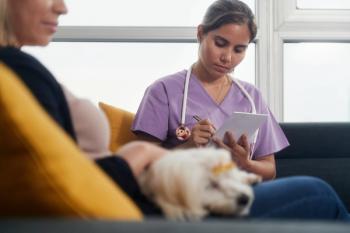
CVC Highlights: 3 ways to address canine fear-related aggression in your clinic
Dr. Wayne Hunthausen will help you treat-and prevent-fear-related aggression in all your canine patients.
1. START BY PREVENTING IT IN PUPPIES
My most important recommendation is to work with puppies to prevent aggression from developing in the first place. To do this, keep lots of puppy kibble and other small treats on hand in the examination room. On a puppy's first visit, give it lots of treats throughout the examination: Touch the puppy, give it a treat. Auscultate its heart, give a treat; examine its ears, give it a treat. When you vaccinate, put a big spoonful of peanut butter or a handful of kibble on the examination table to distract the pup and make that experience as enjoyable as possible. By following this routine throughout the examination, you'll teach the puppy to associate your touch with a positive experience, reducing the likelihood of the puppy becoming fear aggressive.
Dr. Wayne L. Hunthausen
Also, encourage puppy owners to drop by your clinic once or twice a week with their new puppies to establish a relationship with the veterinarians and support staff. At my practice, every free staff member takes a few moments to welcome these puppies with treats.
2. TURN AROUND A SNARLING PUPPY
If an 8- or 9-week-old puppy brought in for its new puppy examination leans against its owner or snarls when I approach it, I postpone examination or vaccination for a week or two if possible. I'll tell the owner "Looks like this pup's having an off-day, and I want its visit to be fun. So today let's just talk about important things like house-training and parasite prevention."
I then ask the owner to bring the puppy in once a day or at least three times a week for the next week or two. And I tell the owner to bring a pouch of cooked chicken pieces to give the puppy. During these visits, every staff member available pets the dog and gives it treats as well—often with the puppy on the examination table. After doing this, I've seen amazing turnarounds in one to two weeks in puppies that showed high arousal and fear on their first visit. These puppies learned to like the veterinary staff and to enjoy their visits to the clinic.
Sharon Montrose / Getty Images
3. DEALING WITH AN AGGRESSIVE ADULT DOG
Of course, it's harder to train an adult dog that is aggressive in the examination room, especially a dog that has, for example, been held down for a procedure such as anal sac expression. In these dogs, the behavior problem is likely entrenched, so it may be impractical to take weeks to months to attempt to correct the problem by having the pet visit for treats, especially if there is a medical problem that needs to be addressed. In these cases, drug therapy is probably necessary.
I initially prescribe an oral medication such as trazodone, clonidine, or alprazolam. See Table 1 for dosages.
Table 1 Recommended Dosages for Alprazolam, Clonidine, and Trazodone in Aggressive Dogs
Have the owner start at home with a dose at the lower end of the range to see how it affects the dog and to determine the duration to effect. Most pets will respond within one to two hours. If necessary, have the owner gradually increase the dose during subsequent trials until the dog is very relaxed yet responsive and able to walk up and down stairs safely. Once the proper dose is determined, ask the owner to administer that dose one to two hours before the dog's next clinic appointment.
At the clinic, approach the dog slowly, initially avoiding eye contact but giving the dog treats (the treats must be highly desirable, such as meat or cheese). Gradually make eye contact while continuing to give the dog treats. If the dog shows signs of aggression, ask the owner to return with the dog after giving it a higher dose of medication. If a dog continues to exhibit fear aggression, an injectable sedative may be necessary.
Dr. Hunthausen is a Veterinary Medicine Practitioner Advisory Board member and co-author of the new edition of Behavior Problems of the Dog and Cat, available in January 2013. (Landsberg G, Hunthausen W, Ackerman L. Behavior Problems of the Dog and Cat, 3rd ed. Edinburgh: Saunders Elsevier, 2013.)
Wayne L. Hunthausen, DVM
Animal Behavior Consultations
Westwood Animal Hospital
Westwood, KS 66205
SUGGESTED READING
1. Beaver BV. Canine behavior: insights and answers, 2nd ed. Philadelphia: Saunders Elsevier; 2009.
2. Beaver BV. Feline behavior: a guide for veterinarians, 2nd ed. St. Louis: Saunders; 2003.
3. Crowell-Davis S. Veterinary psychopharmacology. Hoboken, NJ: Blackwell; 2005.
4. Crowell-Davis S, Landsberg GM. Pharmacology and pheromone therapy. In: Horwitz DF, Mills DS eds. BSAVA manual of canine and feline behavioural medicine, 2nd ed. Gloucester, UK: BSAVA; 2009.
5. Dodman N, Shuster L, eds. Psychopharmacology of animal behaviour disorders, Oxford: Blackwell Scientific;1998.
6. Gruen ME, Sherman BL. Use of trazodone as an adjunctive agent in the treatment of canine anxiety disorders: 56 cases (1995–2007). J Am Vet Med Assoc 2008;233:1902–1907.
7. Kuehn NF. North American companion animal formulary, 9th ed. Port Huron, Mich: North American Compendiums, 2010.
8. Ogata N, Dodman NH. The use of clonidine in the treatment of fear-based behavior problems in dogs: an open trial. J Vet Behav 2011;6:130-137.
9. Plumb D. Plumb's veterinary drug handbook, 7th ed. Ames, Iowa: Wiley Blackwell; 2011
10. Sherman BL, Mills DS. Canine anxieties and phobias: an update on separation anxiety and noise aversions. Vet Clin North Am Small Anim Pract 2008;38:1081-1110.
Newsletter
From exam room tips to practice management insights, get trusted veterinary news delivered straight to your inbox—subscribe to dvm360.





